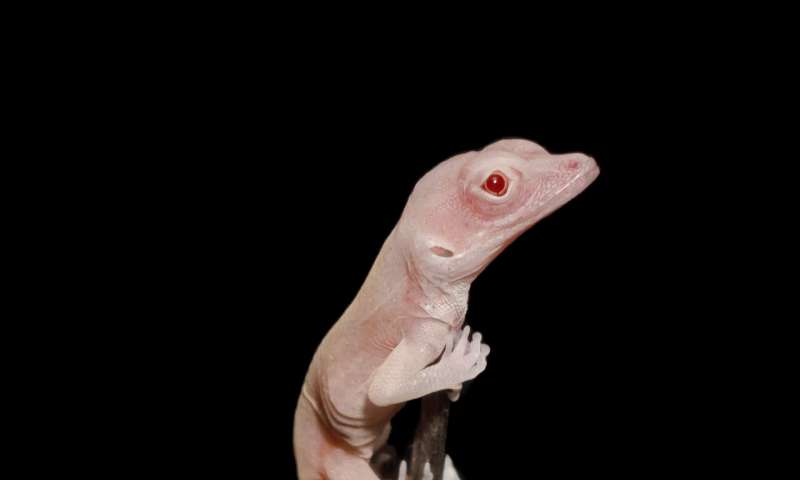Researchers report producing the first gene-edited reptiles ever.

Image credits Doug Menke.
A new study reports on the use of CRISPR-Cas9 to create albino brown anole lizards (A. sagrei). No other team has successfully applied gene-editing techniques to reptiles. The study also shows that the gene-edited lizards can also pass the modified genes for albinism to their offspring.
CRISPy lizards
“For quite some time we’ve been wrestling with how to modify reptile genomes and manipulate genes in reptiles, but we’ve been stuck in the mode of how gene editing is being done in the major model systems,” says corresponding author Doug Menke, an associate professor at the University of Georgia.
“We wanted to explore anole lizards to study the evolution of gene regulation, since they’ve experienced a series of speciation events on Caribbean islands, much like Darwin’s finches of the Galapagos.”
In most model species (such as lab rats, for example) CRISPR-Cas9 is employed by injecting gene-editing vectors into freshly fertilized eggs or single-cell zygotes (i.e. after fertilization). However, this approach can’t be used on reptiles, as they employ an internal fertilization process making it hard to predict when an egg becomes fertilized. It’s also hard to isolate a single-celled embryo from momma lizard, which means we can’t transfer it out into a lab dish and work on it.
Menke and his team, however, noticed that the transparent membrane over the species’ ovary allowed them to track all of the developing eggs, including which eggs were going to be ovulated and fertilized next. They then decided to inject the CRISPR elements into unfertilized eggs within the ovaries.
“Because we are injecting unfertilized eggs, we thought that we would only be able to perform gene editing on the alleles inherited from the mother. Paternal DNA isn’t in these unfertilized oocytes,” Menke says.
He explains that it took three months for the lizards to hatch, and says that the procedure is “a bit like slow-motion gene editing”. By the end, the researchers found that about 6% to 9% of the oocytes, depending on their size, produced offspring with gene-editing events. Around half of the edited lizards held modified genes from both parents. The findings indicate that the CRISPR components remain active for several days, or even weeks, within the unfertilized eggs.
In some other model animals, CRISPR-Cas can have efficiencies up to 80% or higher, which would make the present 6% seem like a paltry amount, Menke explains.
“But no one has been able to do these sorts of manipulations in any reptile before,” he says. “There’s not a large community of developmental geneticists that are studying reptiles, so we’re hoping to tap into exciting functional biology that has been unexplored.”
The team decided to use albinism genes for the study because they result in an obvious physical trait (loss of pigmentation) without being lethal to the animal. Secondly, they wanted to use the lizards as a model to study how the loss of pigmentation impacts retina development, as humans with albinism often have vision problems. The anole lizards are ideally suited for this: their eyes have a fovea, a pit-like structure in the retina that underpins high-acuity vision, which humans share, but most of our main animal models lack.
Ultimately, this gene-editing technique could be translated for use in other animals, Menke adds.
“We never know where the next major insights are going to come from, and if we can’t even study how genes work in a huge group of animals, then there’s no way to know if we’ve explored everything there is to explore in the realm of gene function in animals,” Menke says.
“Each species undoubtedly has things to tell us, if we take the time to develop the methods to perform gene editing.”
The paper “CRISPR-Cas9 Gene Editing in Lizards through Microinjection of Unfertilized Oocytes” has been published in the journal Cell Reports.






